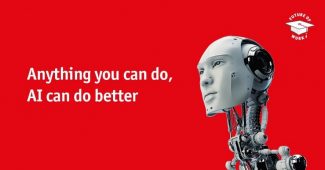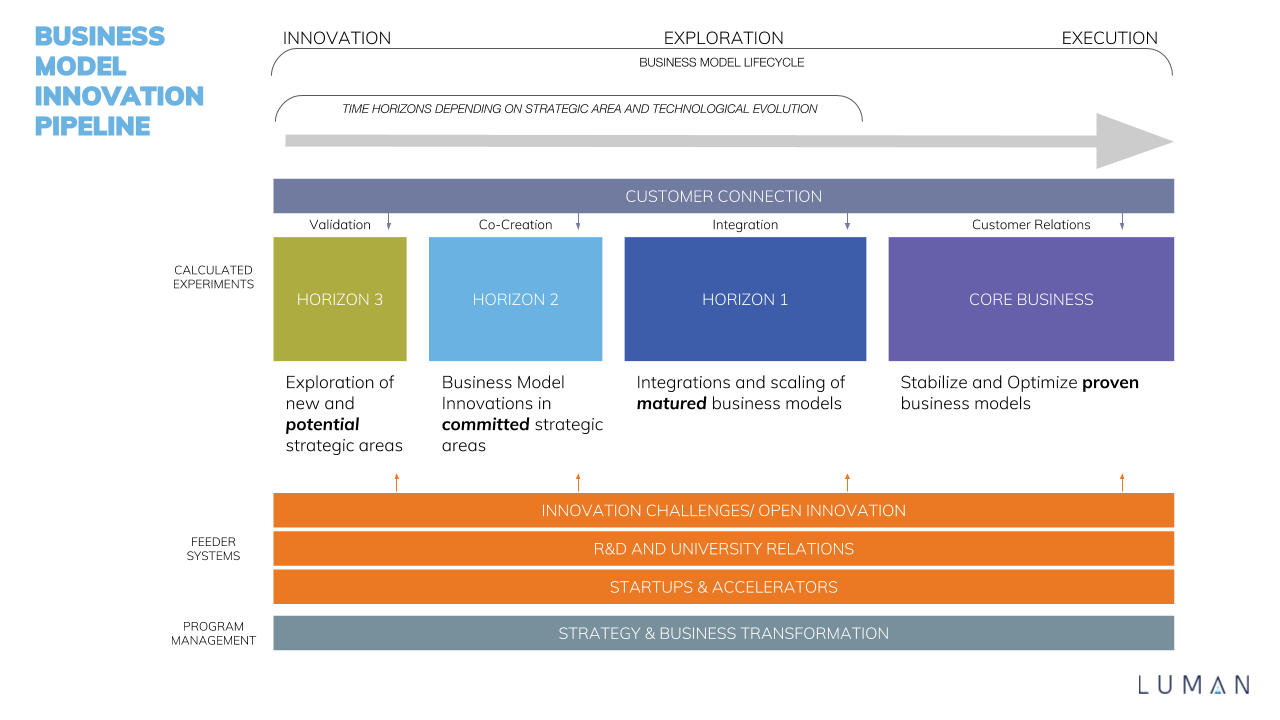Artificial Intelligence + Intrapreneurship = Future of Organizations?
AI + Intrapreneurship = Future of Organizations?
By Philip Horvath
Philip is a culture catalyst – planetary strategist – supporting leaders with operating systems at planetary scale – tweeting on future and culture @philiphorvath

Photo by Nadine Shaabana on Unsplash
“The most exciting breakthroughs of the 21st century will not occur because of technology, but because of an expanded concept of what it means to be human.” — John Naisbitt, futurist and author
Much has been written about AI, and how its continuous advance into our lives seems inevitable:
Andrew Ng, Google Brain, and Coursera co-founder and Stanford professor speak of it as “the new electricity”. Others speak of the tremendous opportunities for business — a recent PwC study estimates that AI will drive as much as a $15.7 Trillion increase in the global economy by 2030.
Others speak of the displacement of half to as much as 80% of jobs in the coming decade or two — and, while hit the hardest, it will not just be low skilled workers, but also affect current high-end jobs like financial analysts, lawyers, and physicians.
Beyond that, more and more prominent scientists and business leaders like Stephen Hawkins or Elon Musk are concerned that, unless checked and guarded with ethics, AI might indeed turn us into human batteries or get rid of our meatbags altogether.
The one thing nobody seems to be doubting is that AI is coming. And coming fast.
While it gets thrown around a lot, the term “exponential” actually does apply to the growth of AI. With deep learning, we are now not just tasking machines with specific tasks like facial recognition or evaluating health scans, or using more general AI to learn how to play videogames or ultimately drive cars, but we are letting the machines learn by themselves — now nearly at the speed of a human being. Google’s AlphaZero recently mastered all the chess knowledge in history in a snapping four hours.
While policy makers and theorists are exploring ways to mitigate the coming of the “useless class” through measures like universal basic income or VR religions (Matrix anyone?), there is also a another fundamental question at play:
What does the future of organizations look like in a world of AI?
Forget “future of work”, “industry 4.0” or any other fancy name. In the end it is about a simple question:
“How do we provide opportunities for meaningful activity for every individual of this planet which in turn provides them with the means and resources to unfold themselves to their highest potential — while working in service to life and value creation?”
While technology has continued to enable shifts in how we work over the last centuries, we are in the midst of a major conceptual shift. What is being transformed on a rudimentary level is not just work, but the meaning of work and how we organize collective collaborative endeavors.
This is an equivalent shift to the advent of factories, back then replacing local craftsmanship and corresponding apprenticeship learning paths, with mass (and over-) production of goods, and government education systems to create compliant consumers and factory workers (blue or white collar), trained in Rote learning in order to later execute on repeatable processes.
To understand conceptual level shifts, think about the concept of “home”. At first, a home used to be just shelter. Then it became the place where you grow food or do your work. Now “home” is a place for entertainment — away from work, a place where you find respite and store and display your material acquisitions.
To understand the future of organizations and the conceptual shift taking place, we will need to step up from concrete to conceptual.
On a conceptual level an organization is a contextual container: It provides the why, the how and the what for a collective endeavor.
Just as a shift happened from “working to survive” to “working to create disposable income”, we are now in yet another conceptual shift toward “work as a means of self-expression”.
Let’s look at the new why, how and what of organizations and the changes that AI is bringing.
WHY? — From Profit to Purpose
In the past, the why of an organization was to create profit. Profit comes from Latin “proesse” and roughly translates to “may it be beneficial”. Over time, and in our desire to create safe bets, we have eroded our concept of profit to some of the metrics we can use to measure it.
Traditional financial KPIs tell us more about our efficiency than our efficacy, and even more meaningful measures of organizational impact still only provide a historical view. They let us know whether we are moving in the direction we intend to move in.
When we confuse them with the goal, we fall short of actually achieving impact and instead begin to erode the quality of our offerings in chasing deltas. The result has been that since the efficiency wave and the takeover of finance as the drivers of business in the 80s Wall Street craze, strategy has often been limited to cost savings and head count reductions, in turn eroding psychological safety for most corporate workers and slowly destroying their capacity to perform — psychological safety being the key requirement for high performing teams, as Google found out.
It is hence not surprising that half of the S&P 500 companies have vanished since 2000, and another half will be replaced within the decade — many of which already seem more like zombies than living organisms.
Profit is no longer a sufficient motivation.
It has to be put back in its place as a mere indicator of efficiency, while we shift our focus to the global impact any organization creates by its mere existence.
In a world of expanding transparency, organizational purpose, corporate culture and brand are becoming increasingly intertwined and transparent.
Today’s — and even more so tomorrow’s — customer requires purpose. No longer can companies dazzle consumers with branding efforts, while internally their culture is toxic, and their focus is merely monetary profit.
In a world where all kinds of information is readily available, memes spread faster than ever, and a level of luxury allows for consumption choices, organizations must have a shared purpose with their customers in order to attract and retain them.
On the other end of the value chain, we are witnessing one of the largest generational turnovers — about 10,000 baby boomers are retiring per day in the US alone. Millennials are beginning to replace much of our current workforce. Raised in the belief that they can actually impact the world, they too require purpose and meaning in their work.
Purpose as a foundation has become inevitable if you want to attract tomorrow’s high potential talent.
Purpose serves as an overarching operating principle and allows for constant innovation beyond an organization’s current business model. Purpose also provides an anchor in VUCA environments, where velocity in decision making is key.
And velocity in decision making is what AI excels in. As such, AI requires purpose, as purpose provides the context for ethics in how we utilize and exploit AI capacities.
AI requires some basic operating principles that allow for decision making in uncertain situations.
Purpose and values — those immeasurable distinctly human things, are becoming key for the encroaching of the machines.
Today’s basic pocket calculator already outperforms most humans in math. Tomorrow, advanced machine learning systems will outperform most humans at pretty much most cognitive tasks — and for sure any repetitive ones.
HOW? — From Mechanics to Meaning
 A business done efficiently is a collection of optimized repeatable processes, in which each process step is simplified to the point where the resource executing on it can be easily replaced.
A business done efficiently is a collection of optimized repeatable processes, in which each process step is simplified to the point where the resource executing on it can be easily replaced.
Business is all about repeatable processes.
So is AI.
Any repeatable process, manual or cognitive, will be done by machines in the very near future.
There will be an exponential progression from AI first doing basic repetitive tasks, then more and more independent decision making, becoming assistants, then ultimately — with growing libraries — allow us to design entire DAOs.
This is frightening to many, especially those who have made their living with repeatable processes: From bricklayers and super market cashiers, to Excel jockeys copying and pasting and pivoting away on the daily.

But why waste precious creative human potential on repetition in the first place?
We are already seeing the effects of repetitive stress syndrome, on physical, emotional, and mental levels. As humans, we are actually not meant to do the same thing every day. So why waste human attention and lifetime on something that does not allow for our full expression?
Fast forward to a world where every child has an AI assistant ready, eager and capable to aid them in creating entire ecosystems of impact.
Liberated from executing on repeatable processes, the future human will utilize AI to create value in ever new ways.
This is where the focus of “How?” of an organization is shifting from repeatable processes, a machine metaphor fitting for the age of industrialization, toward a value creation network, more akin to a fractal organism than a linear command and control structure.
The “How” will be about creating environments for collaboration with purpose and permission, with psychological safety and support, allowing individuals to fully express themselves creatively in service toward a common purpose.

The quality and variety of products and services that will arise from such a world will be a stunning cornucopia.
WHAT? — From Product to People
As AI and human ingenuity will enable the creation of ever new products at nearly unimaginable speeds, the “What” of an organization will be changing so fast, holding on to a specific product or idea of a product will be foolish.
There will be no more “core business” to defend against innovation. Instead, there will be a constant business model and value creation pipeline with corresponding support services, allowing new value creation networks to be continuously spun off inside the organizational ecosystem.

Instead of a focus on products or services, “What” will become about a customer domain; about continuously adding real value to people’s lives and lifestyles.
This is where empathy and design thinking become crucial. Real empathy, not lip service.
To truly connect with your customers requires vulnerability and courage, it requires depth in relationships and human capacities that have been mostly falling into the domain of unrecognized care work.
New technology requires new humans
Aristotle talked about a feedback loop between epistome, our belief systems and views of the world, and techne, our art and craft of expressing those systems and views.
New consciousness creates new technology, new technology inspires new consciousness.
In the last century, fueled by a new synthesis of individuation technologies, a new human consciousness took hold, creating first basic computers, then networks, then the internet, and in parallel, we continued to make our machines smarter, more like ourselves.
These new technologies created by a new level of consciousness now began to inform the next wave of consciousness evolution as people began to use them — nature seeks level.
New technology requires new humans. AI is learning fast. Now humans need to learn to evolve at the speed of technology.
Today’s technology will require and enable a whole new set of individual and inter-personal capacities, specifically self-reliance, self-management, and self-organization:
* Self-Reliance — Understanding oneself as a the source of impact, culture and results independent of position within an organization.
* Self-Management — Being accountable and committed, and having the ability to adapt actions toward success.
* Self-Organization — The ability to take an idea from first signal to launching a new venture, and being able to enroll support and resources.
Intrapreneurship as the new way of working?
That is where intrapreneurship comes in. Originally, when first introduced by Gifford and Elizabeth Pinchot in 1978, intrapreneurship referred mostly to managing a P&L inside of a larger organization. Since, the concept has expanded beyond the structural into also covering cultural domains.
Intrapreneurs are sometimes referred to as corporate entrepreneurs, and while they both require self-reliance, self-management and self-organization, there is a big difference between the two: On a most basic level the risk and reward structures: As an entrepreneur, the risk is high, but so are the potential rewards (you might just create the next unicorn and become a gazillionaire). As an intrapreneur, there is lower risk, there is that steady paycheck, but there is also a much lower reward, often at best a promotion — at least until corporations catch up and create new appropriate incentive and ownership structures.
That is why purpose and permission are key to intrapreneurship. They provide the necessary intrinsic motivation to keep going — often in spite of the organization and its response to innovation.
Personal purpose connected with organizational purpose, the permission and psychological safety to act on it, and the effective use of AI support will define the successful intrapreneurial workforce of the future.
It will require individuals on any level of organization to understand and live the organizational purpose, continuously focus on creating customer value, empathize and learn, and build new processes and systems — and ultimately offerings — together with AI support to provide better intelligence, enable repeatable processes and allow a new level of adaptability.
Companies like IBM have already successfully begun another transformation phase. To support the use of their AI Watson and turn their employees into customer advocates enabled with intelligent technology, they have trained more than 90,000 of their employees in design thinking.
And design thinking is only the first step, next we need LEAN and agile methods to move new ideas into actual businesses, as well as the organizational support to take an idea from first signal to launching prototypes, MVPs and ultimately ever new product lines.
Many companies are beginning to understand that leadership and innovation have to come from everywhere in the organization and have initiated various forms of intrapreneurship programs.
From our work with clients and having conducted workshops at several intrapreneurship conferences over the last years, we have noticed how the themes of culture and human transformation have continued to gain momentum and attention.
The cultural archetype of the Intrapreneur serves as a prototype for the employee of the future.
Through the archetype of the intrapreneur we can indeed expand our concept of what it means to be human, what it means to be a powerful creator inside of a defined system — supported by ever more intelligent systems that increase our ability to gather and analyze relevant information, that enable and require new ways of collaborating, and that allow for our selves and our organizational structures to become ever more adaptable toward a future we wish to create for ourselves and this planet.
In the end, it is about humans and the kind of future we are committed to creating on this planet and beyond…
